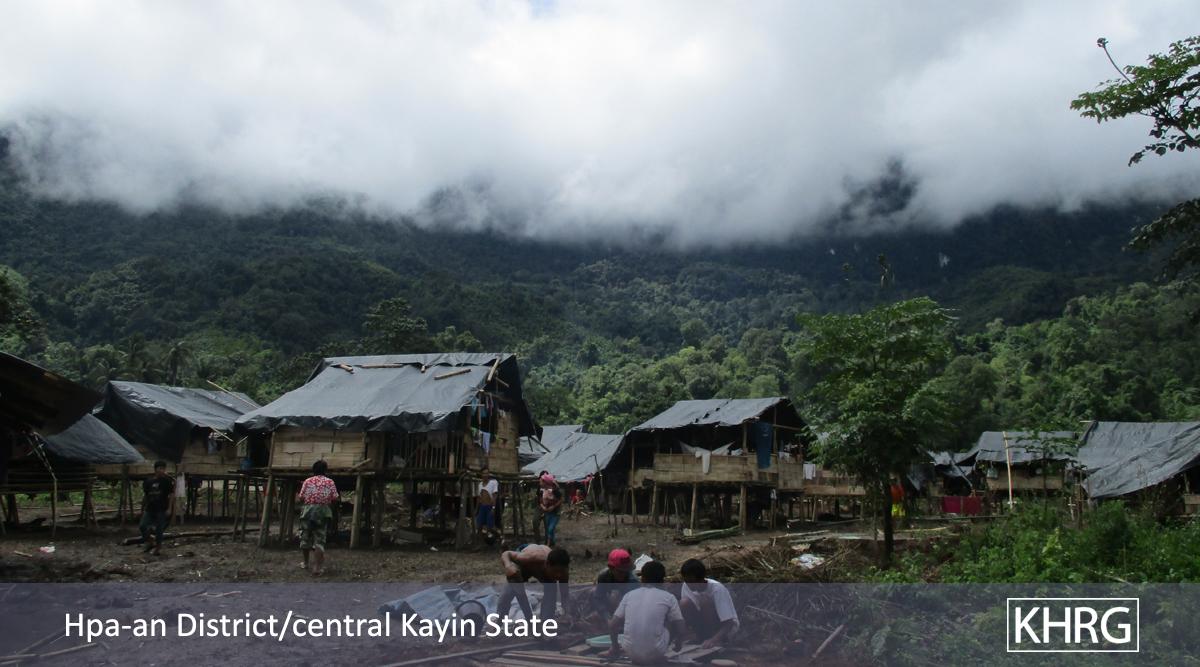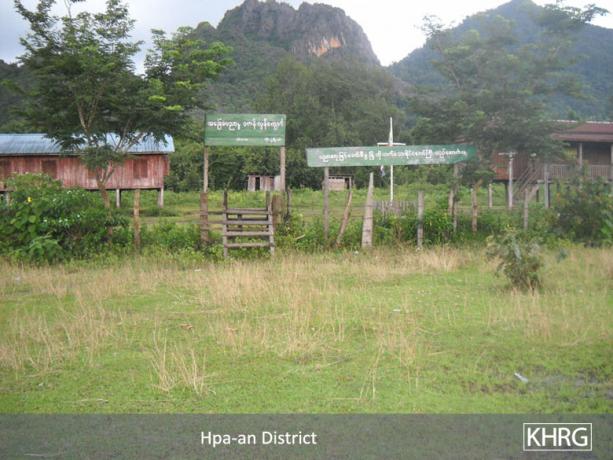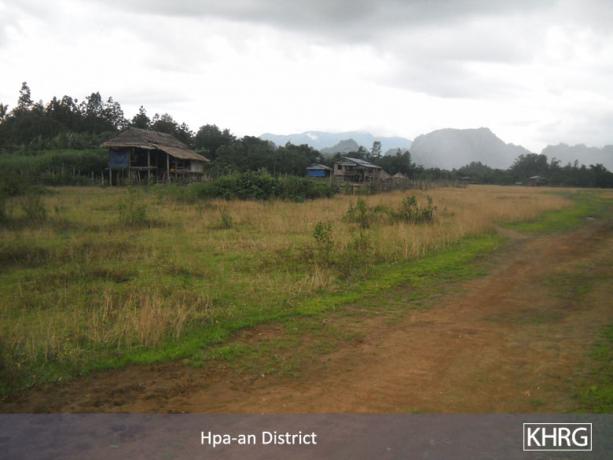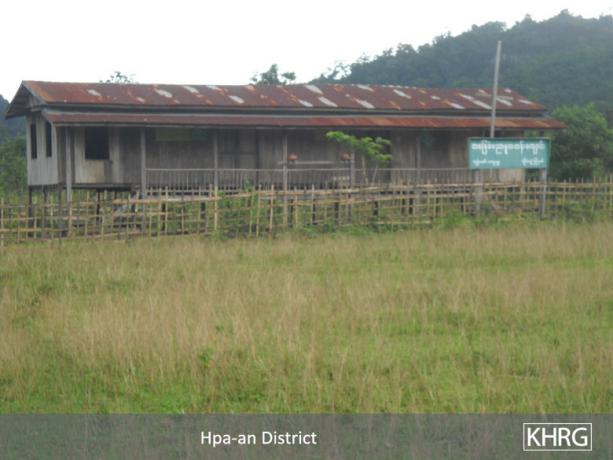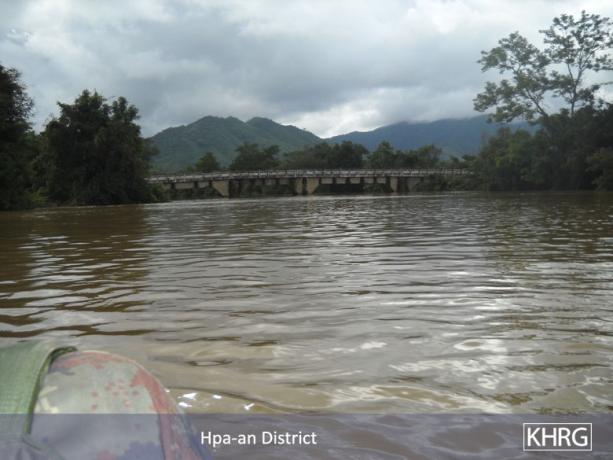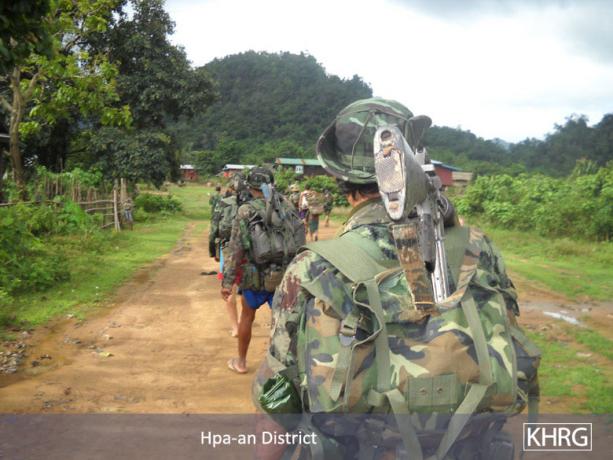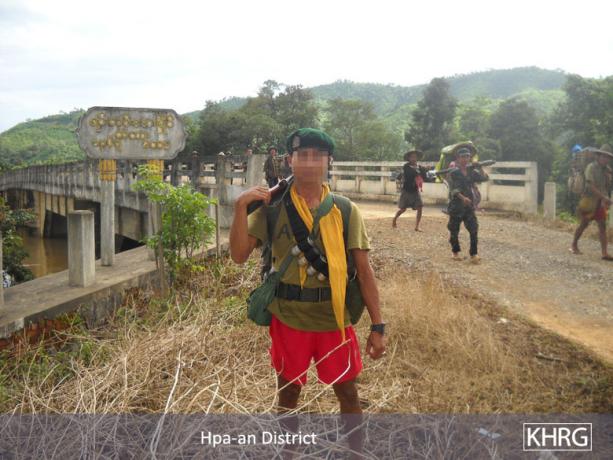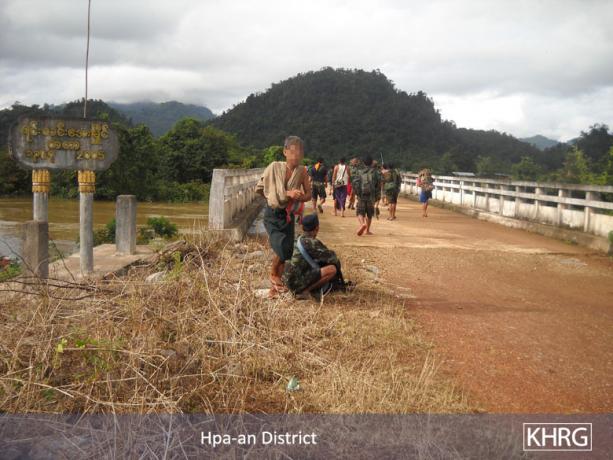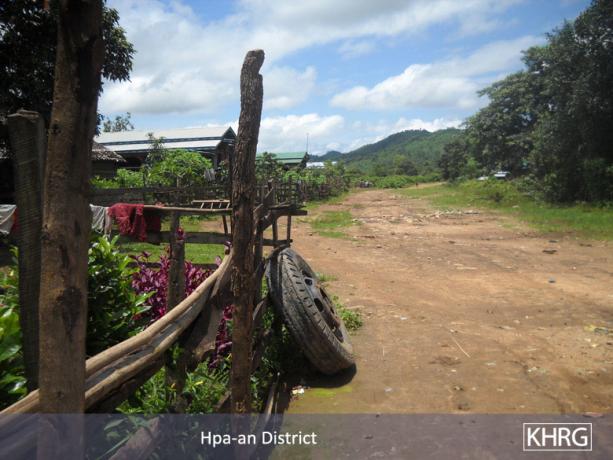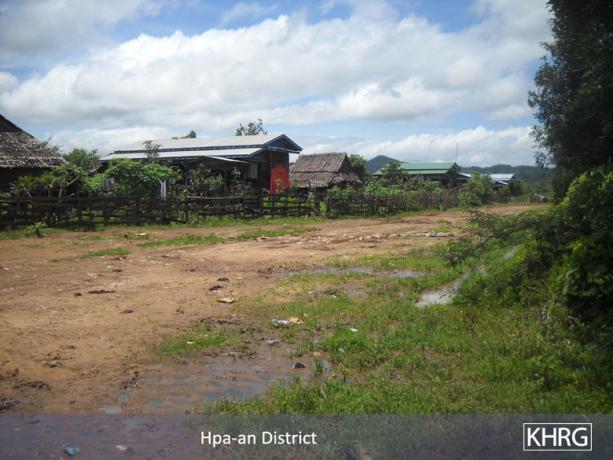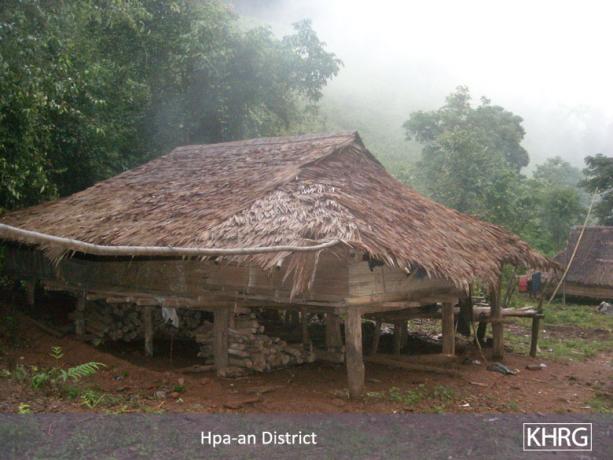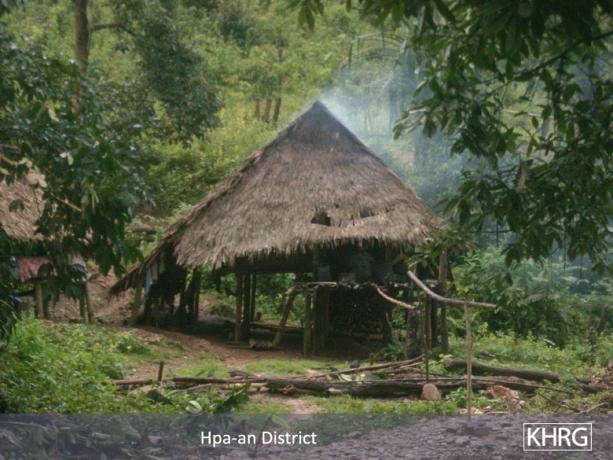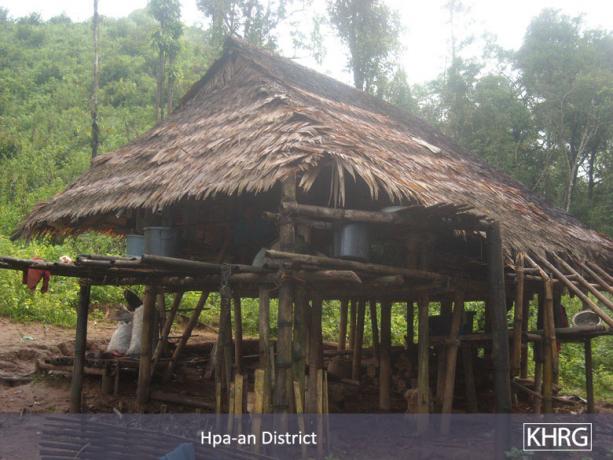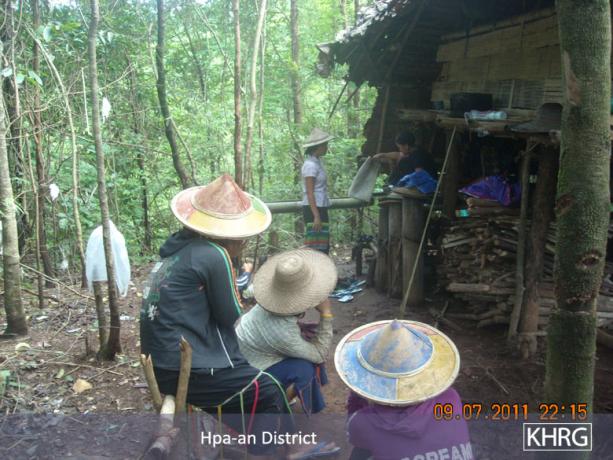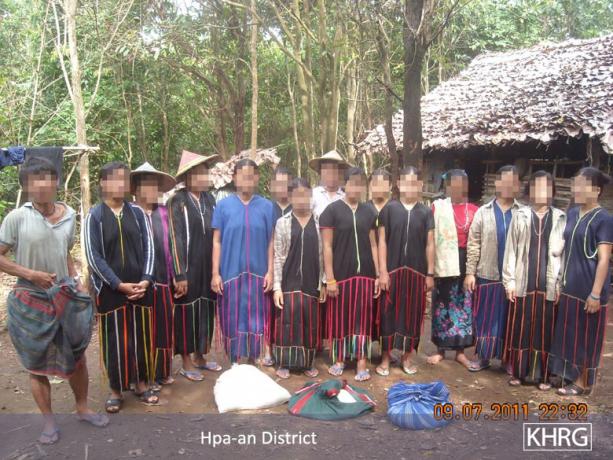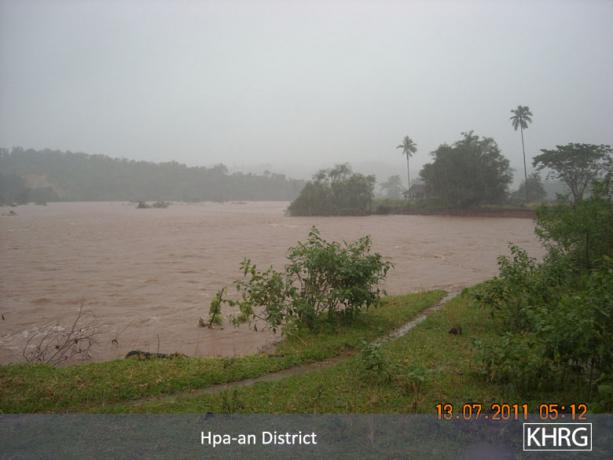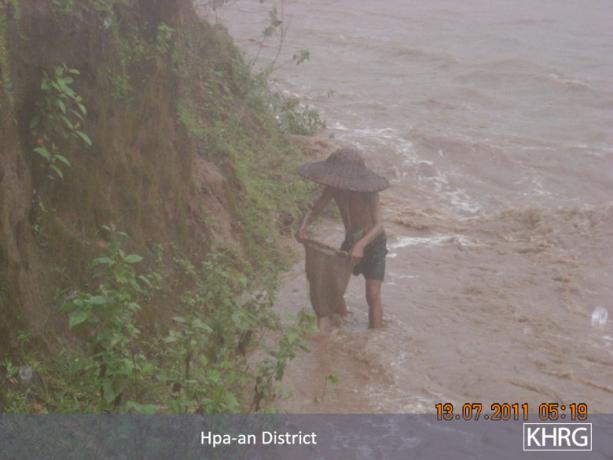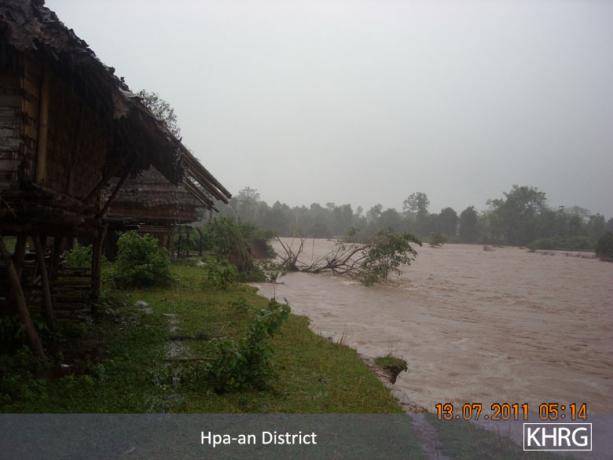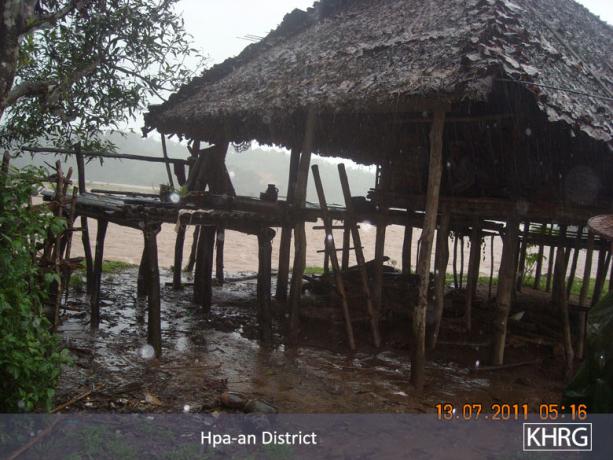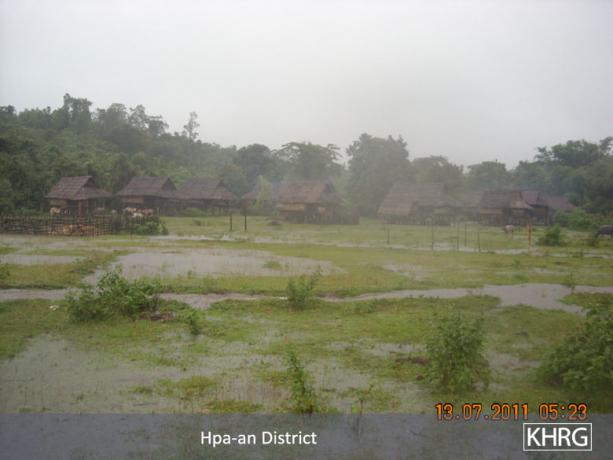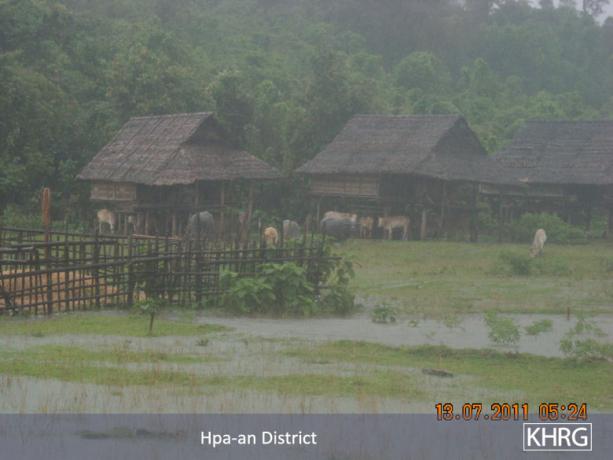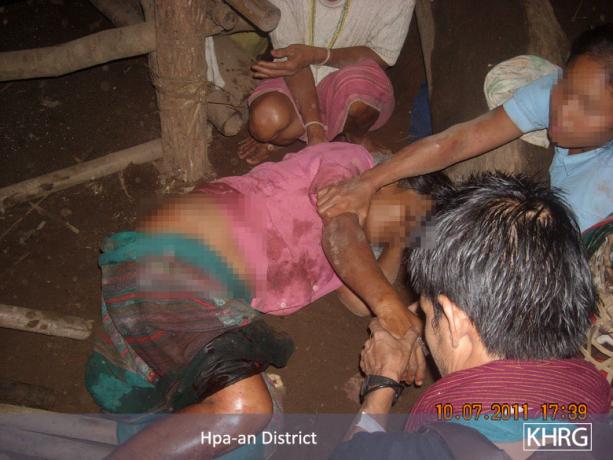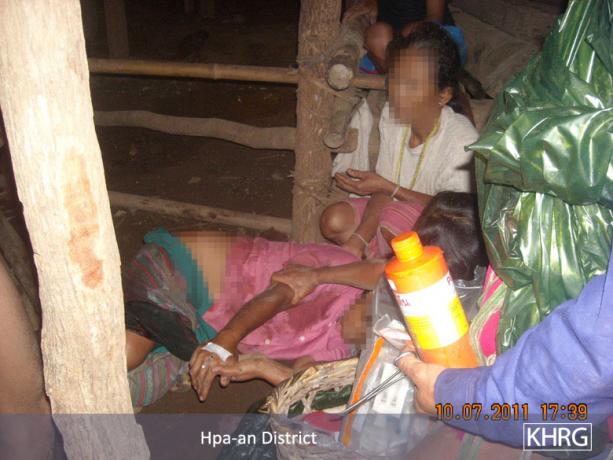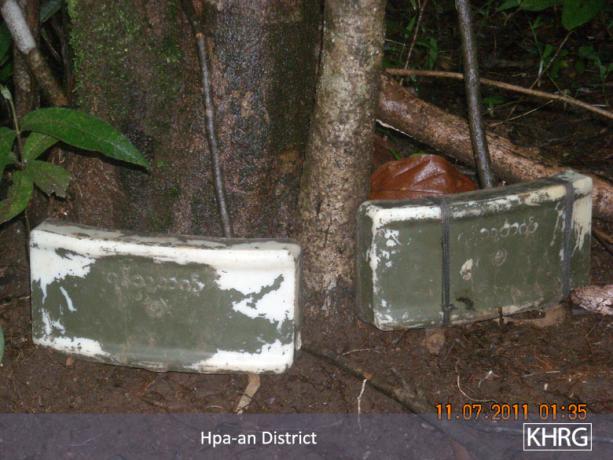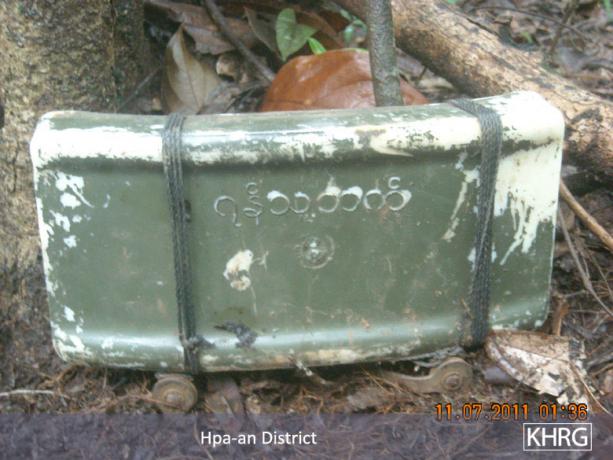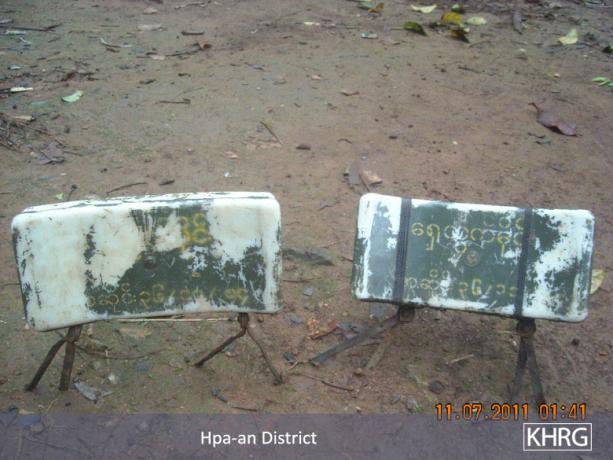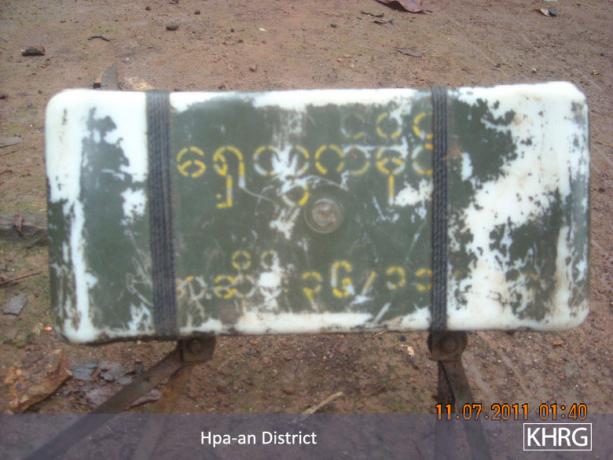This report includes a situation update submitted to KHRG in September 2011 by a villager describing events occurring in Pa'an District between June 2011 and August 2011. It details recent Tatmadaw and Tatmadaw Border Guard activity, including camp locations and troop strength, and incidents related to a forced relocation order issued to eight villages in Lu Pleh Township by Tatmadaw Border Guard units on July 15th 2011. After the July 20th deadline for relocation, Tatmadaw and Border Guard forces commenced joint attacks against six of the villages ordered to relocate, including multiple days of heavy shelling and machine gun fire which the villager who submitted this report described as indiscriminate. On July 20th 2011 Border Guard troops also deliberately killed villagers' livestock and fired mortars into civilian areas of R--- village, injuring a 50-year-old woman, while retreating from an attack by the Karen National Liberation Army (KNLA) on the Border Guard camp in R---. This report further documents Tatmadaw Border Guard demands for forced labour and forced porters. The villager who submitted this update raises villagers' concerns related to flooding along the Dta Greh [Hlaing Bwe] River during the 2011 monsoon season, and the abandonment of schools and loss of trade and livelihood opportunities due to forced relocation. This report notes that, in response to the abuses and concerns mentioned above, villagers in Pa'an District adopt strategies that include: moving to areas beyond Tatmadaw control, monitoring local security conditions, and hiding food stores in the jungle.
Situation Update | Pa'an District (September 2011)
The following situation update was written by a villager in Pa'an District who has been trained by KHRG to monitor human rights conditions. It is presented below translated exactly as originally written, save for minor edits for clarity and security.[1]This report was received along with other information from Pa'an District, including 47 photographs.[2]
Tatmadaw locations and activity
In early June 2011, the SPDC Army [Tatmadaw][3] unit which was active in Lu Pleh [Hlaing Bwe] Township was LIB [Light Infantry Battalion] #548. Their battalion commander, Thu Koh, commanded one column of [more than] 50 soldiers and they always [regularly] conducted operations around Lu Pleh Township's main road connected to the Gklaw Gka Htee army camp. This SPDC Army unit also cooperated with the [Tatmadaw] Border Guard forces based in the Kaw Taw [Myaing Gyi Ngu] area.
Column #1 of SPDC Army LIB #231, which is commanded by Battalion Commander Thu Koh, has been active along the main road between Gklaw Gka Htee and Meh Th'Waw village, on the [Burma – Thailand] border.
In the border places, such as Meh Ta Ree, Kler Day and Pway Poe Gklah, the army units that have been active there are Column #2 of LIB #231 and Column #2 of LIB #548, with over 40 soldiers in each column.
In Dta Greh [Bpaing Kyon] Township, the SPDC Army unit which has been active in the Htee Bper area is LIB #548, with nearly 60 soldiers under Battalion Commander Thu Koh. They came and conducted operations sometimes, but the area was flooded so travelling was not easy. They were active when they could be. The base for this army unit is Dta Greh [Bpaing Kyon] army camp.
There has not been a lot of SPDC Army activity in the border areas. They only sat in their camps, such as Bpoo Lu Tu 1248 [a military location] and Gka Teh (Ta Lay) army camps. There are 25 soldiers in Bpoo Lu Tu and 45 soldiers in Gka Teh. They have not yet conducted any special operations. These SPDC Army units always just waited for the Border Guard to conduct operations, and got information from them. The SPDC Army unit based in Bpoo Lu Tu is LIB #549 under Camp Commander Thee Ha Aung.
Border Guard locations and activity
In early June [2011], most Border Guard activities were in Lu Pleh Township, such as in the Kaw Taw [Myaing Gyi Ngu] area and on the Lu Pleh main road between Gklaw Gka Htee and Meh Th'Waw. In early June, Border Guard commanders arranged their soldiers and attacked the DKBA and the KNLA forces in villages of the Kaw Taw area and around Kaw Taw.
The Border Guard commanders managing these forces were Major General Tun Laing, Major General Pah Nwee, and Colonel Maung Chit Thu. These commanders had orders to secure the area and set up outposts. They appointed Battalion Commander Laing Thee of Border Guard Battalion #1019 as combat operations commander. They joined forces with ten SPDC Army soldiers from the Klo Pa Doh heavy weapons unit and they started attacking villages and forcibly relocating civilians as ordered. There were about 80 soldiers and they went from village to village as they had been ordered.
For the border areas, there was no special activity in the three townships. In Lu Pleh Township border areas, such as Meh Ta Ree and Wa Shu Koh, Column Commander Maw Lah Wah managed Border Guard Battalion #1015 with 45 soldiers. For Dta Greh Township border areas, the SPDC Army unit that took responsibility in the areas of Ler Bper Her, Gklay Moe Ta and to Gka Teh was Border Guard Battalion #1020 with nearly 60 soldiers under Battalion Commander Sar Lin. Border Guard Battalion #1015 set up their headquarters in Yar Tah village in Dta Greh Township. Border Guard Battalion #1020 set up their headquarters in Gkoh Gkoh in T'Nay Hsah [Nabu] Township.
Forcible relocation of civilians and displacement
On July 15th 2011, the Border Guard units managed by Major General Tun Laing, Major General Pah Nwee and Major Maung Chit Thu ordered village heads together and forced all of them to move their villagers from their villages and relocate to the Kaw Taw [area]. Villages that were ordered to leave were: L---, N---, B---, A---, M---, W---, P--- and K---. Within five days, the villagers had left and, while some went to Kaw Taw, there were a lot of people who fled to other places.
The photos below [top and bottom left] are of P--- village. All the villagers there fled and only houses remain [bottom left]. The photos [top] show the P--- village high school where lessons have stopped. Villages such as B---, A---, M---, W--- and P--- had only one school [between them] and so all of these villages' students attended the P--- high school [before it closed].
The photo bottom left is of K--- village from which villagers were forced to relocate. The villagers left K--- village and they were separated because some went to Kaw Taw and some to other places. The photo shows the K--- primary school which was abandoned and where teaching has stopped.
The photos below are of B--- village from which villagers were forced to relocate, and now all the villagers have fled. The building of the big bridge was organised by a senior monk in Kaw Taw and served as an important travel and trade route in connection to which the villagers did business. Since the villagers were forced to relocate, the villagers' businesses have been ruined. No one stayed in the village. Some went to a relocation site [at Kaw Taw], and some went to other places. The photos below show the same bridge that was organised by the monk. There used to be shops and stalls for selling things beside the bridge.
All the villages that people had to leave were located in Lu Pleh Township, Pa'an District. Since 1995, it has mostly been the DKBA forces that have stayed in those villages and there were a lot of villagers who were DKBA soldiers. Now, there are problems between the DKBA and the Border Guard for which villagers are blamed and, because of the SPDC's trickery, even the Karen now have conflict and are fighting amongst themselves.
Border Guard attacks on villages
On July 20th 2011, a Border Guard force with about 80 soldiers commanded by Border Guard Battalion #1019 Battalion Commander Laing Thin and that had joined with and were led by the SPDC [the ten SPDC Army soldiers from Klo Pa Dohheavy weapons unit] approached L--- village and shelled the village with mortar fire for two days. The reason they shelled [the village] with mortars, the Border Guard said, was that the villagers who had not left and stayed in the village must either be DKBA or KNU [KNLA] soldiers. Those who shelled the mortars for the Border Guard were the SPDC Army soldiers which led the Border Guard soldiers. Ten SPDC Army soldiers formed the mortar [heavy weapons] unit. The weapons that they used during the attack were an 81 mm mortar and one .5 calibre machine gun and they fired them all day. Their soldiers advanced little by little and they took L--- village.
In N--- village, the Border Guard soldiers fired mortar shells from the opposite side of the Salween River, so the villagers did not dare to stay anymore and fled.
After July 20th 2011, the Border Guard left L--- village and came and attacked the DKBA forces based at E---. They attacked with heavy and small weapons fire and they secured the top of the hill, after which they started shelling the A--- bridge area.
E--- was on the top of a hill overlooking B---, W--- and M--- villages, and P--- and K--- villages. Starting on July 25th 2011, they shelled B---, W--- and M--- as well as around the B--- village pagoda; they just shelled like crazy [carelessly]. The village that was damaged most was M---. There were lots of shells that exploded beside the B--- village bridge shown in the photos [above]. They shelled the three villages [B---, W--- and M---] for one day and one night. There are no villagers in these places now.
Village outside of Tatmadaw control
The photos below are of a village called Y--- in Dta Greh Township, Pa'an District. The village is located in the mountains and some villagers from R--- and T--- village came and stayed there. The villagers who live there work in hill fields and hide their rice in the jungle. They have not faced any SPDC Army encounters. They work for themselves and listen to the news. Only the KNLA sometimes comes there. The villagers set up the village many years ago. The villagers say they will never go back to a big village as long as the situation is unstable. They will stay in their hiding place.
Forced labour
The photos below are of villagers from R--- who had to carry food for the Border Guard. R--- village is in Dta Greh Township, Pa'an District. At the start of the rainy season the vehicle road was destroyed [became muddy and impassable due to rain] and the villagers have had to carry rations [by foot] for the Border Guard once a month. It takes one day to carry the rations, but sometimes they have to sleep [spend a night] along the way. Men, women, and all people who can carry rations have to go. They have to go six, seven, ten and sometimes more than ten people at a time. The reason [R--- villagers have to porter] is that there was a Border Guard army camp near R--- village.
The Border Guard unit based in the R--- army camp was Border Guard Battalion #1015. The Camp Commander was Mu Maw Dweh and there might have been about 15 to 20 soldiers there. The soldiers forced the villagers to work for them, such as [repairing] the camp fence, finding firewood, carrying water, acting as sentries and cooking for them. There was no compensation for the villagers. There are no Border Guard soldiers in the camp now. In July 2011, the camp was attacked and secured by KNU [KNLA] soldiers.
Flooding
The photos below are of R--- village. In August 2011, it rained a lot and the Dta Greh River [Hlaing Bwe River] flooded, and it flooded some houses in R--- village. The villagers have had to face many problems. They have had to do forced labour and now they face flooding problems. Some villagers here had to move away from the river [due to the flooding]. They were very happy because the Border Guard camp was not there any more, and they believed they would no longer have to carry rations for the Border Guard once a month. However they did not have long to relax, as now when the Border Guard travels through on patrol, they force the villagers to rotate and go for three days each to porter for them, until they make a new camp in a far away place. Then the villagers are released and they can return [to R--- village].
Villager injured by mortar
The photos below are of Naw P---, 50, in R--- village, Dta Greh Township, Pa'an District. On July 20th 2011, when the KNU [KNLA] were attacking the R--- [Tatmadaw] camp, before the Border Guard soldiers retreated they fired their weapons into R--- village and fired [mortars] so randomly that the mortar shrapnel hit Naw P--- once in the stomach and once in her right thigh. The Border Guard soldiers shot everyone's pigs and goats that they saw. Naw P--- was hit by mortar shell shrapnel that lodged itself in her stomach. After the Border Guard retreated, the villagers sent the woman who was hit [Naw P---] to the KNU [KNLA] medics and she was injected [with a sedative] and treated. In the afternoon, she was sent to A--- hospital. The piece of shrapnel was successfully removed. It [the operation and treatment] took five days and it cost more than 600,000 kyat (US $723).[4] She had to borrow [money] from other people. That [the cost] was the biggest thing that affected this villager's life. When she could not [afford to] pay any more money, she came back to her village and contacted her friends on the border, and she was sent to a hospital in Thailand. After that, in the first week of August, she was sent to the O--- hospital.
Claymore mines
Border Guard Battalion #1015 from the R--- camp used the landmines in the photos below. They placed them at the back of the grounds near the [R---] camp gate. The SPDC Army supplied them with these landmines. The Border Guard force there was controlled by the SPDC Army, and they did as they were ordered.
Footnotes:
[1] KHRG trains villagers in eastern Burma to document individual human rights abuses using a standardised reporting format, conduct interviews with other villagers, and write general updates on the situation in areas with which they are familiar. When writing situation updates, villagers are encouraged to summarise recent events, raise issues that they consider to be important, and present their opinions or perspective on abuse and other local dynamics in their area.
[2] When these documents have been processed and translated by KHRG and when sufficient information has been compiled and analysed, a full Field Report on the situation in Pa'an District will be available on the KHRG website. Until then, KHRG's most recent analysis of the situation in Pa'an District can be found in the recent Field Report, "Functionally Refoulement: Camps in Tha Song Yang District abandoned as refugees bow to pressure," KHRG, April 2010.
[3] In Karen, the Burmese phrases Na Ah Pa (SPDC) and Na Wa Ta (SLORC) are commonly used to refer to the Burmese government or to Burma's state military, the Tatmadaw. Many older Karen villagers who were accustomed to using the phrase Na Wa Ta (SLORC) before 1997 continue to use that phrase, even though the SLORC has not officially existed since 1997. Similarly, despite the official dissolution of the SPDC in March 2011, many Karen villagers continue to use the phraseNa Ah Pa (SPDC) to refer to the Burmese government or to the Tatmadaw; see: "Mission Accomplished as SPDC 'dissolved'," Myanmar Times, April 4-10 2011. The term Na Ah Pa was used by the villager who wrote this report, and "SPDC" is therefore retained in the translation of this report.
[4] All conversion estimates for the Kyat in this report are based on the fluctuating informal exchange rate rather than the government's official fixed rate of 6.5 kyat to US $1. As of October 25th 2011, this unofficial rate of exchange was US $1 = 830 kyat. This figure is used for all calculations above.

